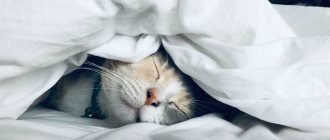Pregnancy in Maine Coons is longer than in other cat breeds. Therefore, kittens appear on average 7 - 10 days later than usual. How do the first signs of pregnancy appear and when should you expect babies? How to help the expectant mother and what complications may there be? What should a first aid kit consist of and what should be the place for childbirth? As well as advice on caring for a woman in labor.
First signs
The first signs of pregnancy appear approximately 3 weeks after the start of the last estrus. These include:
- Swelling of the cat's nipples (they become bright pink).
- Slight weight gain.
- No heat. The cat calms down and no longer asks for the cat.
- Changes in taste preferences (for example, the expectant mother begins to show interest in food to which she was previously indifferent, and vice versa).
There are no tests for feline pregnancy, but an interesting situation can be detected through ultrasound.
Progression by week
Veterinarians distinguish the following stages of pregnancy by week:
- 3 weeks after mating, the first signs appear.
- At 3–4 weeks, the cat develops toxicosis (due to hormonal changes). In this case, drowsiness occurs and appetite worsens.
- In the fifth week, the expectant mother noticeably gains weight. The cat's appetite improves and its belly becomes rounder. The pet becomes calmer and more affectionate.
- At 6 - 8 weeks, kittens begin to move (this can be noticed when observing the pet). Maine-kunsha becomes anxious and tries to find a secluded place to give birth.
- The ninth and part of the tenth week is the last period of gestation. The pet loses its appetite and begins to actively lick its belly and vulva.
During the period of contractions, the cat rushes about in search of a suitable place and meows loudly, attracting the owner’s attention and demanding help and care from him. This period lasts about a day, after which labor begins.
How many kittens does a primiparous cat give birth to?
When purchasing a cat, you need to understand that over time it will grow up and often produce offspring. These animals are particularly fertile and can give birth up to 3 times a year. How many kittens does a cat give birth to for the first time is a question that interests every owner. A lot or a little, and what if there is just one or seven? Of course, having many kittens is difficult for both the pet and the owner, because, in the end, he will have to place them in good hands.
And not all furry murkas are titled, where the waiting list for their children is scheduled for years in advance. And if you are against sterilization, then you need to study everything about the cat’s pregnancy and the birth process. Because at least once a year you will have to take them. I would also like to note that domestic pets are less adapted to life compared to their street relatives, so they often require the help of their owner, and sometimes a veterinarian. So, let's talk a little about cat pregnancy itself.
How many kittens can a cat give birth to for the first time?
The most important and logical question. Typically, sexual maturity in an animal occurs at the age of 8-9 months. And now she will be able to get pregnant and bear offspring, but this is a risk factor, because the body is still too young.
And if in the natural environment we cannot influence this fact in any way, then it is recommended that pets not be mated until they are 1 year old. It’s even better to wait until 1.5 years, when the animal is stronger and ready to bear full-fledged and healthy offspring. Typically, first-time cats carry and give birth to a small litter of 1-3 babies. This is explained by the not yet fully formed reproductive system. Old-time cats also give birth to few kittens, because their reproductive function is already fading. Well, healthy cats in their prime usually give birth to up to 6 kittens. Nature has decreed that cats only have 8 nipples.
Source
When are we expecting babies and how many will there be?
A pregnant cat lasts an average of 9 - 10 weeks (or 70 - 72 days).
Moreover, the duration of gestation greatly depends on the number of kittens in the litter.
The more there are, the sooner they will be born (in order to reduce the load on the body, the cat gives birth faster).
Babies born before the 62nd day have poor health and therefore require special care (otherwise they risk not surviving). In Maine Coons, the number of kittens in a litter is approximately 4 - 6, but there are cases where cats of this breed carried 10 kittens.
It is not recommended to feel the belly of a expectant mother in order to determine the number of fetuses in the womb, since it is possible to damage the vital organs of the cat - the mother or the offspring she is carrying.
Vitamins when feeding dry food
A pregnant cat's need for vitamins also depends on what food she is fed. Some of them contain a balanced vitamin and mineral complex aimed at combating certain problems. To ensure that the necessary substances enter the pet’s body, you should use high-quality food. Some manufacturers produce specialized food for cats in an interesting situation. It is very important to pay attention to the completeness of your daily diet. It must contain the following products:
- fatty fish;
- sprouted greens;
- dairy products;
- liver;
- eggs;
- poultry meat.
It is equally important to control your cat's weight. Overfeeding makes the process of pregnancy and childbirth more difficult. It is advisable to replace two meals a day with four meals a day, while reducing the size of portions. This will help speed up your metabolism, thereby reducing the risk of gaining excess weight.
Help for the expectant mother
The appropriate age for the first pregnancy is 8 - 10 months.
It is during this period (not earlier) that the pet is physically and hormonally ready to become a mother.
The correct course of pregnancy and appropriate care will help not only to avoid complications in the process of bearing kittens and subsequent births, but also to maintain the health of the cat.
It is advisable to start taking care of the animal even before mating with a cat. Therefore, it is important for the owner to know the basics of proper pet care (food, rest, help during toxicosis).
For a beginning breeder: at what time can a cat become pregnant?
When a fluffy, uncastrated young beauty lives in the house, sooner or later the owner is puzzled by the question of what time the cat can become pregnant. Knowledge in the field of physiology, understanding of the characteristics of sexual behavior, and the nuances of reproduction will help you competently approach the problem of keeping and breeding a pet.
Age at which a cat can become pregnant
The cat family is distinguished by its early maturity and fertility. This is also true for pets. A number of factors will influence when a cat can become pregnant for the first time:
The average cat has her first heat, and with it the opportunity to become pregnant, occurs at 6 - 8 months. Later, large breeds and those with long coats mature. In representatives of such breeds as Maine Coon, bobtail, Siberian, Norwegian forest cat, the first heat occurs at 12 - 14 months. Short-haired breeds, as well as outbred animals, can mature before 6 months. Often the first heat is observed at the age of 4 - 5 months. This should be taken into account when keeping a young female in the house.
From the moment of the first heat, the pet is physiologically ready to become a mother and retains this ability for almost the entire adulthood. There is no such thing as menopause in the cat family. The reproductive period begins with the first heat and can last until death. Owners of furry pets should be aware of this feature in order to understand that the answer to the question of how many months a cat can become pregnant is quite simple - immediately after puberty.
When is the best time to meet a cat?
Despite the rapid puberty of the pet, there is no need to rush into mating. The onset of the first estrus only signals the physiological readiness of the organ
Source
Toxicosis
The cause of toxicosis in cats is hormonal changes in the body, and in some cases, poor diet. Characteristic symptoms:
- Vomiting in the morning (has a light color and does not contain traces of blood or bile).
- Drowsiness and weakness.
- Increased nervousness.
- Decreased appetite.
- Unhealthy coat.
If you notice signs of toxicosis in a cat, you should not panic, because this is a normal physiological reaction to changes in hormonal levels. Toxicosis, as a rule, can be observed at 2 - 4 weeks of pregnancy, and it lasts on average about 10 days. Usually this condition does not require treatment and goes away on its own. But in case of prolonged toxicosis or significant deterioration of the condition, it is recommended to show the animal to a veterinarian.
For pregnant Scottish and British cats
British and Scottish cats with dense, double-textured coats and massive bones need high-quality B vitamins.
According to reviews from the owners, Kitzim vitamins, produced in the UK, have proven themselves to be excellent. These vitamins do not contain dyes or synthesized artificial chemicals.
In addition to the B complex of vitamins and valuable amino acids, Kitzym vitamins contain a number of important minerals: calcium, phosphorus, iron, manganese, magnesium.
Nutrition and vitamins
Proper nutrition during pregnancy plays an important role in the formation of future babies. Therefore, veterinarians advise feeding your cat a balanced diet (there are special product lines designed for pregnant women). In addition to the daily diet, you can give your furry pet vitamins (Doctor Zoo, Seva, Canina, etc.).
You should not combine fortified feed and vitamins, as this can lead to the development of vitamin deficiency.
Selecting a location
The place for cat birth must be prepared in advance.
A large cardboard box is perfect for this purpose (approximate parameters: length and width at least 90 cm, height - 50 cm).
At the same time, one wall of the box needs to be trimmed a little so that it is convenient for the nursing mother to jump into the house (including so that she does not crush the kittens).
It is recommended to place soft bedding at the bottom of the box. During pregnancy, the cat needs to be introduced to the place for future birth. It is advisable to place the box in a quiet place where no one will disturb the mother and kittens.
How many kittens does a cat give birth to for the first time?
When a person gets a pet, namely a cat, he must understand that after some time it will grow up and begin to produce offspring. It is worth emphasizing that these animals are especially prolific and can give birth up to several times a year. Many readers are interested in this question: how many kittens does a cat give birth to for the first time? After all, if the offspring turns out to be large, this will be a problem for both the cat and the owner. The first one should feed all the children, and the second one should be sure to place them in good and caring hands.
It should be noted here that not all purrs have a breed and are very much in demand among furry lovers. If sterilization is not to your liking, but you don’t even want to “drown” small kittens, then you should thoroughly study all the information regarding the pregnancy of cats, as well as the process of their birth.
First cat birth: how many kittens can appear
Often, a cat reaches sexual maturity at around nine months. Already at this time, she can become pregnant and be able to bear future offspring, but with some possible risks, because the animal’s body is still too young and weak.
So, in the natural environment, a person cannot influence such situations, but for domestic animals it is strongly recommended not to mate until they reach the age of 1 year. However, it will be better if you wait 1.5 years - by this time the animal will be stronger and prepared to bear healthy offspring.
Typically, primiparous cats are able to bear and give birth to a relatively small litter (from one to three babies). Why is that? It’s simple - the reproductive system of the “young” is not yet fully formed. By the way, old-time mothers also have small litters due to the fact that their reproductive function is already on the decline. What to
Source
First aid kit for feline birth
You should stock up on tools for your cat's first aid kit in advance. So, during childbirth you cannot do without the following devices:
- Alcohol for disinfection.
- Scissors.
- Disposable diapers (they can be purchased at a veterinarian's store or pharmacy).
- Soft cloths or napkins (may be needed for rubbing newborn kittens).
If the owner has not previously taken part in a cat’s birth and is afraid, you can call a veterinarian to your home for a fee.
Tips for caring for a new mother
The expectant mother requires special attention and special care. During this period, veterinarians recommend adhering to the following rules:
- Trim the hair around the pregnant woman's nipples (with scissors without sharp ends).
- A few weeks before giving birth, protect your pet from sudden movements.
- Spend more time with your cat (especially in the last days before the kittens are born).
- Do not take your pet on long trips.
- Provide your cat with healthy nutrition, peace and comfort.
- Give any medications only after consulting a veterinarian.
- After giving birth, keep the cat's house clean (change the bedding periodically).
- Monitor the color and consistency of your cat’s discharge during the postpartum period. Normally they have a reddish color, but after 4 - 6 days they acquire an increasingly lighter shade. If the cat is very weak, it is necessary to carefully remove discharge from the thighs and vulva using a damp towel.
- Provide the mother in labor with plenty of fluids.
- It is recommended to place bowls with food and water close to the cat's shelter.
- Do not let your pet go for walks during pregnancy and after giving birth (as she can pick up an infection from other cats and cats, and subsequently infect still immature kittens).
If a woman in labor appears weak, refuses to eat, body temperature rises to 38 - 39 degrees, or if the mammary glands become inflamed, consult a veterinarian immediately.
Maine Coon birth
There is still debate about how long pregnancy lasts in Maine Coon cats. Breeders who have a Maine Coon cattery count the term differently: some from the first day of mating, and others from the last or plus one day. Mating can last several days and pregnancy does not occur immediately, so gestation periods may differ by 5-10 days. On average, a Maine Coon cat's pregnancy lasts 66-68 days.
Pregnancy of a Maine Coon cat Pregnancy and childbirth in cats of this breed are usually quite easy, the maternal instinct is well developed. But you need to start taking care of the cat during pregnancy, then the birth will be easy and smooth.
A pregnant cat may become less active and sleepy. Her appetite will increase, during this period she really needs more food, it should be nutritious and balanced. In some cases, vitamins and supplements, such as calcium, will not be superfluous. Sometimes at 3-4 weeks the cat suffers from toxicosis; the animal may vomit once or twice and feel unwell for some time. At the same time, the cat’s nipples swell and the belly begins to grow. The most common mistake is a person’s desire to touch a cat’s belly and try to manually determine how many kittens she is carrying. You should not do this, such manipulations can lead to complications in the Maine Coon’s birth. Do not pick up a pregnant cat; prohibit children from doing this. If you still need to pick up or move the cat, then hold it with one hand under the chest and the other under the butt.
Preparing for the birth of a Maine Coon cat Prepare a place for the cat to give birth in advance. A regular spacious box will do just fine. On the one hand, it will need to be trimmed in such a way that a pregnant cat can easily jump in there and after giving birth she can see where she is jumping in order to protect the kittens from injury. Also, the wall of the box should be high enough so that three-week-old kittens, who are already crawling well, cannot get out of there.
Line the box with clean paper, newspapers, and diapers. Prepare yourself a “obstetrician’s kit” for giving birth to a Maine Coon cat. You may need: - sharp, clean scissors for cutting the umbilical cord; — disinfectant: alcohol, sterilium for hands, instruments; - homeopathic medicine traumeel for injection - sold in a regular pharmacy, it is believed that it helps a cat during childbirth, making all muscles elastic; - several pipettes for traumeel; — clean cloth and disposable diapers for cats and kittens; - a small enema to suck out fluid from the kittens’ mouths if they choke on amniotic fluid during childbirth; — “pants” for cats with long hair. You can use two socks or something else, the point is to protect long hair from contamination. — preliminary agreement with a veterinarian, emergency veterinary service numbers.
Giving birth to a Maine Coon cat On the day of giving birth, the cat begins to behave restlessly; she may frequently visit the toilet, rush around the house in search of a secluded place, or crawl into her box and lick herself thoroughly, especially under her tail. 3-5 days before giving birth, the Maine Coon cat may have mucous discharge and the stomach will drop down.
Talk to your veterinarian in advance about traumeel in feline birth. If he approves, then the first five drops should be given to the cat at the beginning of contractions and then given every 15 minutes until the end of labor.
At 2-4 full-fledged contractions the kitten should appear, and at the next one it should be born. The kitten is born in a “bag”, which can rupture on its own, or the cat will begin to process the cub and rid it of everything unnecessary - films, blood, mucus. But the cat’s maternal instinct does not always immediately awaken and she needs help - carefully remove the film from the kitten’s face, cut the umbilical cord, 6-8 cm away from the tummy, and slip it under the cat’s nose. If she remains indifferent here, start rubbing the kitten dry with a clean diaper, and if necessary, remove water and mucus from the mouth with an enema. It is very important that the kitten immediately shows signs of life - squeaking, breathing, crawling. The kitten should be followed by a child's place - the last. You can let your cat eat it or throw it away.
The interval between the birth of kittens is increasing, on average one is born after 20 minutes - 1 hour, but a cat can give birth to the last kitten even after 24 hours. If labor subsides and the cat plans to rest, then slip the kitten to her chest. Sucking stimulates labor, the flow of milk, the emergence of maternal instinct and has a beneficial effect on the well-being of the newborn. When labor continues, remove the kitten to a warm, dry place to prevent the cat from crushing it.
After the birth of the last kitten, the cat calms down. If you feel the belly, it may seem that there is another kitten left in the womb. But most likely, this is simply a non-contracting uterus.
When the birth is over, line the box with clean diapers, place water and cat food nearby, and return the kittens to her. Now mother and newborns will rest.
After giving birth, a cat will experience vaginal discharge for 7-10 days. They should be insignificant, reddish-brown in color, not scarlet, and without a strong odor.
How to resuscitate a kitten in labor with a Maine Coon cat If you have carried out basic hygiene procedures (removed the films, sucked out the liquid), and the kitten is not breathing, then place it in your palm, with your feet to your wrist, and support your head with your fingertips. Fix the head and shake your hand sharply so that the kitten is head down. Do this 3-5 times; very often, choked kittens after this procedure begin to cough and breathe. If this does not help, then you can try again to suck out the liquid with an enema, perform artificial respiration, and use a contrast shower. But, of course, such manipulations should be carried out by an experienced person, a veterinarian or a breeder who has a Maine Coon kennel.
When should you call the vet? — The cat is in strong labor, good contractions, but she has not been able to give birth for 1-2 hours. - Bleeding with bright scarlet blood for 10-15 minutes during labor and after. — A sharp and strong rise or fall in temperature to 40 and above or below 37 degrees. — A kitten is stuck in the birth canal and there is no movement of labor for more than 10 minutes.
Possible complications
In the absence of proper nutrition, in case of hypothermia or overheating of the body, if the cat is infected with pathogenic microorganisms, the following complications are possible:
- Miscarriage (usually occurs at 4–5 weeks of pregnancy). In this case, lifeless fetuses may remain in the uterus, which will cause putrefaction and inflammation of the internal genital organs. In this case, you cannot do without the help of a veterinarian.
- Bleeding. It occurs as a result of rupture of the cervix during childbirth: scarlet fluid flows profusely from the vulva, and the cat lies on its side with its tongue hanging out. In the absence of timely treatment, the animal may die.
- Mastitis (inflammation of the mammary glands as a result of excess milk). In this case, redness and soreness of the nipples are observed, and yellowish breast discharge appears. In this case, the cat is isolated from the kittens and special treatment is carried out.
- Metritis (inflammation of the uterus due to infection). In this case, the animal becomes apathetic, the body temperature rises, and there is abundant discharge from the vulva with an unpleasant odor.
- Insufficient amount of milk (occurs, for example, with a large number of kittens, with a lack of adequate nutrition or fluid).
Natural food supplements
Natural food supplements can be purchased at a veterinary clinic or pet store. When choosing, you should follow the recommendations of specialists. On average, the cost of a vitamin supplement ranges from 100 to 600 rubles. It depends on the popularity of the manufacturer and the composition of the product. The dosage is calculated based on the weight of the pregnant animal.
Among the supplements to complete natural nutrition are:
- Brewer's yeast;
- fish fat;
- bone meal.
We recommend reading: What are the benefits of fish oil in capsules, instructions for use, reviews
Brewer's yeast is a natural source of B vitamins. Fish oil includes vitamins A and D. The body needs them to improve the absorption of phosphorus and calcium. Bone meal contains the right ratio of vitamin P and calcium. This tandem has a beneficial effect on the process of formation of the musculoskeletal system.
Comment! A pregnant cat should receive at least 250 ml/kg of calcium per day.











